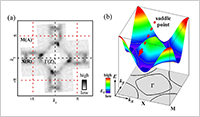Enlarge Image
Electronic structure of optimally doped novel superconductor La(O,F)BiS2
The newly-discovered layered superconductor, Ln(O,F)BiS2, discovered in 2012, achieves a maximum Tc of 10.6 K. The superconductivity emerges by carrier doping to the parent compound.
There have been no reports on the direct observation of the electronic structure of Ln(O,F)BiS2 in the optimal doping range, which is an important factor to consider in a discussion of the superconducting mechanism.
Now, Kensei Terashima and colleagues at Okayama University have clarified the electronic structure of nearly optimal doped La(O,F)BiS2.
The team grew single crystal samples by a flux method. They then performed photoemission experiments at BL-28A of Photon Factory and BL25SU of SPring-8.
The Fermi surface topology of optimally doped BiS2 is about to change due to the presence of van Hove singularity (saddle point) in its electronic structure, which agrees well with the prediction by first principles calculations which take the spin-orbit coupling into account.
The optimal Tc could be realized by EF-crossing of the van Hove singularity in the density of states. On the other hand, despite its higher DOS, Tc of optimally-doped La(O,F)BiS2 is lower than that of the related compound, under-doped Nd(O,F)BiS2. Thus there are probably other factors also enhancing Tc in this system, which will need to be clarified by further study.
Reference:
・ Authors: K. Terashima1,2, J. Sonoyama1, T. Wakita1,2, M. Sunagawa1, K. Ono3, H. Kumigashira3, T. Muro4, M. Nagao5, S. Watauchi5, I. Tanaka5, H. Okazaki6, Y. Takano6, O. Miura7, Y. Mizuguchi7, H. Usui8, K. Suzuki8, K. Kuroki8, Y. Muraoka1,2, and T. Yokoya1,2
・ Title of original paper: Proximity to Fermi-surface topological change in superconducting LaO0.54F0.46BiS2
・ Journal, volume, pages and year: Physical Review B 90, 220512(R) (2014).
・ Digital Object Identifier (DOI): 10.1103/PhysRevB.90.220512
・ Journal website: journals.aps.org/prb/abstract/10.1103/PhysRevB.90.220512
・ Affiliations: 1Graduate School of Natural Science and Technology, and Research Laboratory for Surface Science, Okayama University., 2Research Center of New Functional Materials for Energy Production, Storage, and Transport, Okayama University., 3High Energy Accelerator Research Organization (KEK), Photon Factory., 4Japan Synchrotron Radiation Research Institute (JASRI)/SPring-8., 5Center for Crystal Science and Technology, University of Yamanashi., 6National Institute for Materials Science., 7Department of Electrical and Electronic Engineering, Tokyo Metropolitan University., 8Department of Physics, Osaka University.
・ Department website: http://www.science.okayama-u.ac.jp/~surface/eng

